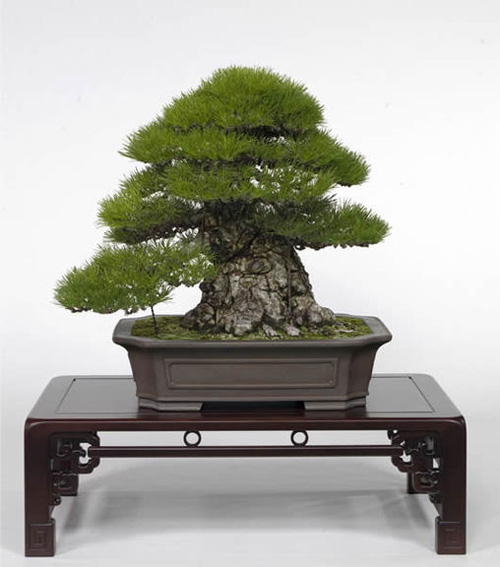 This powerful kuromatsu (Japanese black pine) won the Culture Minister’s Prize at the 20th Green Festa Kokubunji bonsai fair (has anyone out there heard of this fair?). It is 19″ (48cm) high and about 55 years old. It is owned by Toyoyuki Hamabata from Takamatsu’s Mure town in Shikoku. It appears at Bonsai World, an English language website from Shikoku Japan.
This powerful kuromatsu (Japanese black pine) won the Culture Minister’s Prize at the 20th Green Festa Kokubunji bonsai fair (has anyone out there heard of this fair?). It is 19″ (48cm) high and about 55 years old. It is owned by Toyoyuki Hamabata from Takamatsu’s Mure town in Shikoku. It appears at Bonsai World, an English language website from Shikoku Japan.
Bonsai World’s comments
Here’s what bonsai world has to say about this tree: This kuromatsu (Japanese black pine) tree is relatively young. Its ”nebari” root spread is good and it stands up dynamically. Its trunk form clears the conditions for a good bonsai tree — the tree has a thick root and tapers off toward the top. The No. 1, No. 2 and No. 3 branches come out superbly. It is a promising kuromatsu tree.
It is well-potted, and attention has been paid even to minute details. The more the cultivator gives it care, the better it will be. As it is well qualified to be a bonsai tree, it should grow into a wonderful ”moyogi” tree with pronounced bends and curves.
A propensity for understatement
Japanese sometimes have a propensity for understatement, so we’ll take that into consideration. But fifty five years is relatively young? It’s a promising tree? Makes you wonder why they gave it best in show. Wouldn’t honorable mention do for a young promising tree?
Still the leader
I don’t want to overstate the obvious, but Japan is still the leader in world bonsai, especially when it comes to temperate zone trees (tropicals are another story). Their standards are very high and their respect for tradition and innovation continues to push the art of bonsai forward. We’d do well to pay attention to what they are up to.
Your comments?
Wow, I love this tree!
This is a spectacular tree with amazing, continuous trunk taper. My interpretation of being a “young tree” is that the refinement phase has only started recently. If one were to look inside the canopy then it may be that the age of the branches and degree of ramification appears to be younger than the apparent age of the trunk.
To me, this tree seems to be exhibiting proportions usually seen in Mame and Shohin trees. I was very surprised to see that it is nearly 50 cm (20 inches) tall. This makes the trunk base 29 cm (11 ½ inches) across! The tree is only 1.7 times taller than the trunk diameter which makes it a very stubby indeed. An older, traditionally recommended proportion is 1 to 6 or even 1 to 10 for a taller, more elegant tree. At a 1:6 proportion, the tree would be 174 cm (68 ½ inches) tall! The proportions in bonsai have changed towards much thicker trees in the past few (25??) years and this tree is a prime example of the current fashion.
When one starts a bonsai the temptation is often to keep as much as possible resulting in trunks that are very thin compared to the height of the tree and size of the foliage canopy. You do get elegant, thin bonsai and skinny natural trees but it is a good idea to analyse pictures of trees that inspire you and you will often see that they are thick powerful trees that are quite short relative to their trunk diameter.
A thin bonsai only works if the trunk contains power or drama in another form such as rough, aged bark, shari, dramatic movement or, in the case of a Japanese maple, maturity of trunk with elegant, neat flow onto main branches and scars are old an mature. These features are rarely present in newly established bonsai from commonly available stock.
I have often found that a dull, ordinary bonsai is suddenly given new life if redesigned by chopping off most of the height of the tree and focussing attention on the now “thick” trunk.
Thanks Carl. I agree and don’t think I need to add anything.